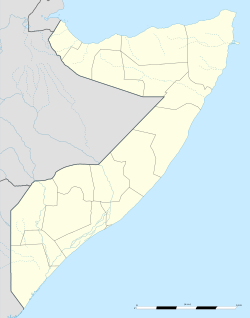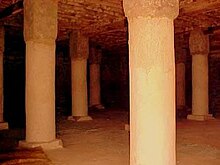Hafun
Hafun
Xaafuun حافون Οπώνη | |
|---|---|
Town | |
 One of the forts of the Majeerteen Sultanate in Hafun (early 1900s). | |
 Hafun Location in Somalia. | |
| Coordinates: 10°25′00″N 51°16′00″E / 10.41667°N 51.26667°ECoordinates: 10°25′00″N 51°16′00″E / 10.41667°N 51.26667°E | |
| Country | |
| Regional State | |
| Region | Bari |
| District | Hafun |
| Founded | 16th century BC |
| Population (2000) | |
| • Total | 13,200 |
| Time zone | UTC+3 (EAT) |
Hafun (Somali: Xaafuun; Arabic: حافون; Ancient Greek: Οπώνη, Italian: Dante) is a town in the northeastern Bari province of Somalia. Situated in Ras Hafun on the coast of the Guardafui Channel, it is the centre of the Hafun District, and the easternmost town in continental Africa (this means that it sees the first sunrise on the African continent). It is an ancient town previously known as Opone.
History[]

Hafun has been identified as the ancient trading port of Opone, which was described in the 1st century CE Greek travelogue the Periplus of the Erythraean Sea. Pottery found by an expedition led by Neville Chittick, in Oponean tombs at Damo, date back to the Mycenaean kingdom of Greece that flourished between the 16th century BC.[1] Merchants from as far afield as Indonesia and Malaysia in the Far East also passed through the settlement. By the 50 CE, the area was well known as a centre for the cinnamon trade, along with the barter of cloves and other spices, ivory, exotic animal hides, and incense. It also traded in tortoiseshells.[2]
During the early modern period, Hafun was a part of the Majeerteen Sultanate's realm.
In 1930, an Italian firm invested capital to exploit salt deposits in Hafun and Hurdiyo. The Italians renamed the city Dante and created the biggest salt production plant in the world.[3] By 1933 or 1934, the Hafun salt works were producing more than 200,000 metric tonnes of salt, most of which was exported to the Far East.[4]
Following independence in 1960, the town was made the centre of the official Hafun District.
Demographics[]
As of 2000, Hafun had a population of around 13,200 inhabitants.[5]
Education[]
Hafun has a number of academic institutions. According to the Puntland Ministry of Education, there are 8 primary schools in the Hafun District. Among these are Hurdiya, Laamiye, Gardush and Xandha.[6]
Economy[]

The Hafun Fishing Company was established in July 1992, in Bosaso.[8][9] It was named after Hafun, where HFC also has an office. The firm exports a wide range of fish products to international markets. Among these are lobsters, frozen fish, dried shark meat and fin, which it mainly sends to Yemen, the United Arab Emirates and Oman in the Persian Gulf, as well as some products to Kenya in the African Great Lakes' region. The company is exploring additional global markets for its fish goods.[8]
In late 2014, the Udug Ltd. Company, in conjunction with the United States-based REDD Engineering & Construction Incorporation,[10] began conducting feasibility studies for the renovation of the salt production plants in Hafun, Hurdiyo, and other littoral areas in Puntland. The first phase of the initiative was completed in March 2015 and saw the historic salt works in both towns refurbished following community-wide consultations. According to the Puntland Ministry of Planning and International Cooperation, the project focuses on stimulating entrepreneurship and sustaining job creation. It was inspired by calls for national reinvestment by the Puntland presidential office and the Puntland Chamber of Commerce. Additionally, Redd Engineering official Lowry Redd indicated that the initiative's second phase aims to make the Hafun plant again one of the main global suppliers of salt.[7]
Transportation[]
In 2012, the Puntland Highway Authority (PHA) announced a project to connect Hafun and other littoral towns in Puntland to the main regional highway.[11] The thoroughfare, which is 750 km (470 mi) long, links major cities in the northern part of Somalia, such as Bosaso, Galkayo and Garowe, with towns in the south.[12]
See also[]
Notes[]
- ^ Chittick, Neville (1975). An Archaeological Reconnaissance of the Horn: The British-Somali Expedition. pp. 117–133.
- ^ Charlesworth, M.P. (1970). Trade routes and commerce of the roman Empire (2nd ed. rev. ed.). New-York: Cooper Square Publishers. p. 65. ISBN 978-0815403289.
- ^ Italian cities of Banadir
- ^ Ahmed, Ahmed Abbas. "Transformation Towards a Regulated Economy": 74. Cite journal requires
|journal=(help) - ^ "Somalia City & Town Population". Tageo. Retrieved 4 October 2013.
- ^ "Puntland - Primary schools". Ministry of Education of Puntland. Retrieved 26 May 2013.
- ^ a b "Somalia salt industry revives". Garowe Online. 7 March 2015. Retrieved 8 March 2015.
- ^ a b "Hafun Fishing Company". Archived from the original on 14 July 2014. Retrieved 5 July 2014.
- ^ "Hafun Fishing". Hotfrog. Retrieved 6 July 2014.
- ^ "REDD". REDD Engineering & Construction Incorporation. Retrieved 2017-03-28.
- ^ "Puntland to upgrade Bosaso-Garowe highway". Sabahi. 28 June 2012. Retrieved 6 November 2012.
- ^ "H.E. Abdirahman Mohamed Mohamud (Farole)". Waayaha.net. Archived from the original on 23 March 2012. Retrieved 6 December 2013.
External links[]
- Populated places in Bari, Somalia
- Ancient Greek geography of East Africa
